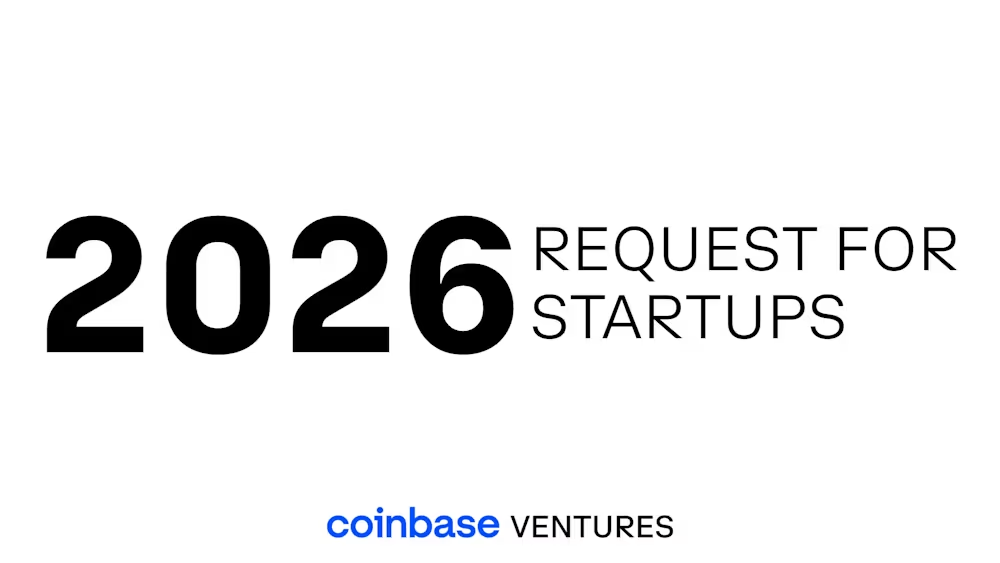Coinbase Ventures' 2026 Preparation Strategy
This article is from Coinbase Ventures .
Compiled by Odaily Planet Daily ( @OdailyChina ); Translated by Azuma ( @azuma_eth )
Editor's Note: The market is sluggish, and narratives are drying up. At this juncture, cryptocurrency investors' faith in the future is wavering, and their direction is increasingly uncertain. However, some teams are still actively reconstructing old narratives and exploring new ones, willing to invest venture capital. The following analysis and reflections from the Coinbase Ventures team on several potential investment areas in 2026 may help you dispel the fog and find a new focus.
The following is the original text from Coinbase Ventures, translated by Odaily.

TL;DR
In the spirit of open collaboration, we are sharing our team's most anticipated ideas in areas such as asset tokenization, professional exchanges and trading terminals, next-generation DeFi, and AI + robotics. We are actively seeking suitable teams in these categories for investment. If you are building in these areas, we would love to connect.
Preparing for 2026
The frontiers of the crypto space evolve every year. In 2025, we witnessed stablecoin infrastructure reshaping the payments landscape, cross-chain proofs reducing settlement times from days to instantaneous, predictive market breakouts gaining mainstream adoption, and new DEX models enabling "everything can be traded on-chain." These achievements have opened up new avenues for ambitious teams working tirelessly to build the next major breakthrough in crypto. If you compare the current market situation to that at the beginning of the year, you'll find deeper liquidity, smarter privacy, more authentic interoperability, and on-chain "tracks" complementing AI. Regardless of price chart fluctuations, we remain confident in the future.
Below are our team's most anticipated visions for 2026, which also answer a question we are frequently asked – "What should I build next?". We believe the following categories will be where the next major breakthrough company or deal will emerge, and these are the areas we are actively seeking to invest in.
RWA Perpetual Contracts – Perpetual Contractualization of Everything
This section is written by Kinji Steimetz (@kinjisteimetz).
With renewed interest in Real-World On-Chain (RWA) assets, investors are seeking new forms of risk exposure, and perpetual contracts—the most proven trading product in the crypto space—offer a structurally faster and more flexible path than tokenization. Thanks to recent improvements in perpetual contract DEX infrastructure, RWA can provide synthetic investment opportunities for off-chain assets through perpetual contracts.
We see this category developing in two directions. First, it's bringing investment opportunities in specific assets onto the blockchain. Since perpetual contracts don't require holding the underlying asset, markets can form around almost anything, enabling the "perpetualization of everything"—from private companies to economic data releases. Second, as the crypto space becomes increasingly intertwined with macro markets, a more sophisticated group of traders is seeking to express broader perspectives beyond just going long on digital assets. This will create demand for on-chain macro asset investment opportunities, allowing traders to hedge or build positions using instruments linked to things like oil, inflation breakeven points, credit spreads, and volatility.
Professional exchanges and trading terminals
Alternative Prop AMM
This section is written by Kinji Steimetz (@kinjisteimetz).
The rise of perpetual contract DEXs, application-specific chains, and rollups highlights the importance of market structure design for building sustainable exchanges, particularly in protecting market makers from malicious order flows. While these newer environments can embed such protection mechanisms directly at the base layer, replicating similar structures on general-purpose chains like the Ethereum mainnet remains extremely difficult without significant protocol upgrades.
We are increasingly focused on projects that can accelerate the development of on-chain market structures within a broader ecosystem. One emerging model is Prop-AMMs on Solana, where resting liquidity can only be executed through aggregators, completely isolating LPs from predatory order flows. This proprietary approach promises to significantly drive market structure innovation before infrastructure improvements arrive, and its potential applications extend far beyond Solana's spot market.
Prediction Market Trading Terminal
This section is written by Jonathan King (@jonathankingvc).
Prediction markets have become one of the most mainstream consumer-facing crypto applications, truly bridging the gap between the native crypto market and mass adoption. However, current prediction markets are suffering from the same fragmentation issues that plagued early DeFi – users have to navigate multiple interfaces simultaneously, tools are extremely limited, and liquidity pools are isolated from each other. Prediction market aggregators have emerged to address this, and we expect them to become the dominant interface layer, consolidating the over $600 million in liquidity currently scattered across various platforms and providing users with a unified view of real-time event odds across platforms.
You can imagine a trading terminal like this (with an interface similar to Axiom, but specifically designed for event contracts): equipped with professional-grade tools, including advanced order types, filters/charts, multi-platform intelligent routing, position tracking, cross-platform arbitrage insights, and more.
Next generation DeFi
Composability of the Perpetual Contract Market
This section is written by Ethan Oak (@0xNoroc).
Perpetual futures are evolving from isolated trading venues into composable DeFi markets, opening up entirely new frontiers for capital efficiency. Major perpetual contract exchanges like Hyperliquid and Lighter are pioneering integrations with lending protocols, enabling users to earn collateral yields while maintaining leveraged positions.
With perpetual contract DEX monthly trading volume reaching $1.4 trillion and growing at a rate of 300% per year, we may see protocols expand the utility of perpetual futures in 2026, allowing traders to hedge, earn yields, and leverage simultaneously without sacrificing liquidity.
Unsecured loans/credit
This section is written by Jonathan King (@jonathankingvc).
The lending market based on unsecured credit is the next frontier for DeFi, and a breakthrough model may emerge in 2026 that combines on-chain reputation with off-chain data to unlock large-scale unsecured loans.
The market opportunity is enormous, with the US alone boasting $1.3 trillion in revolving unsecured credit. The crypto market can easily capture a share of this market through greater capital efficiency and global accessibility. For those building this space, the challenge lies in designing scalable and sustainable risk models. If successful, DeFi will truly become an infrastructure capable of comprehensively surpassing the traditional banking system.
On-chain privacy
This section is written by Ethan Oak (@0xNoroc).
Blockchain is known for its transparency, but widespread mainstream adoption may never be achieved if users cannot maintain their privacy. Institutional and professional retail traders cannot trade with their strategies constantly being leaked to competitors, and ordinary users do not want their entire financial history to be seen by the whole world on the blockchain.
We've seen developers focusing heavily on privacy-preserving assets (like Zcash) and DeFi applications (e.g., private order books, lending/borrowing), as well as privacy blockchains designed specifically for payments. Whether it's building on privacy-focused networks or layering existing public chains with advanced cryptography (ZKPs, FHE, MPC, TEE, etc.), these tools allow blockchains to maintain verifiability while significantly reducing the risk of users being exposed to malicious actors.
AI and Robots
Robotics and Bionic Robot Data Collection
This section is written by Kinji Steimetz (@kinjisteimetz).
As AI continues to expand, the market is beginning to look towards the next technological frontier, with a growing consensus that robotics may define the next phase of innovation. While many teams are working in this direction, a key gap remains in training robots and embodied AI systems: the availability of datasets remains limited and fragmented.
Among these, the most urgently needed is refined physical interaction data, such as grip strength, pressure sensing, and multi-object manipulation (especially deformable materials such as fabric and wires). Although this challenge extends beyond the scope of the crypto industry, incentive-based data acquisition models like DePIN (Decentralized Physical Infrastructure Network) offer a feasible path for large-scale collection of high-quality physical interaction data , which could potentially accelerate the development and deployment of advanced robotic systems.
Human identity verification
This section is written by Hoolie Tejwani (@HoolieG)
We are approaching a tipping point where it will be difficult to distinguish whether everything you see on your internet screen is generated by humans or AI.
We believe that combining biometrics, cryptographic signatures, and open-source developer standards is crucial for establishing a "human proof" solution that will complement AI in new human-computer interaction paradigms. Worldcoin (our portfolio company) has consistently been at the forefront of anticipating and addressing this challenge. We are eager to support multiple solutions to tackle this increasingly complex problem.
AI for on-chain development and security
This section is written by Jonathan King (@jonathankingvc).
Smart contract development is about to usher in its "GitHub Copilot" moment. In 2026, we are likely to see AI agents further lower the barrier to on-chain development—founders without technical backgrounds can launch on-chain businesses in hours instead of months, with the agent responsible for generating smart contract code, conducting security audits, and providing continuous monitoring.
The opportunity lies in Agent tools, which can make smart contract development and security/risk management as easy to learn as modern web development, thereby triggering a "Cambrian explosion" of on-chain applications and experiences.
Opportunities always come from unexpected places.
Looking ahead to 2026, we have high expectations for the builders who dare to take bold risks and drive the on-chain economy forward. These are areas we have already identified as having enormous potential, but the most exciting projects often come from unexpected places.
If you are deeply involved in any of the above areas, or exploring something completely new, feel free to message the team members mentioned above—we look forward to communicating with you and learning about the future you are building.
- 核心观点:Coinbase Ventures看好2026年四大加密投资领域。
- 关键要素:
- RWA永续合约化与专业交易终端。
- 下一代DeFi的可组合性与无抵押贷款。
- AI与机器人、链上隐私技术突破。
- 市场影响:引导资本流向创新赛道,推动行业技术演进。
- 时效性标注:中期影响。



